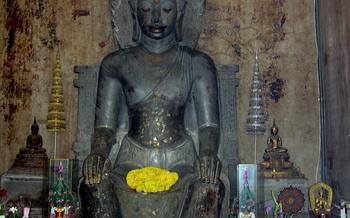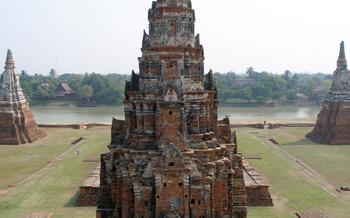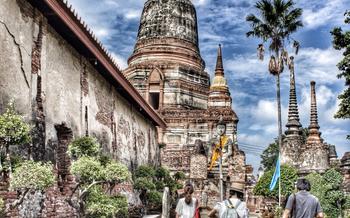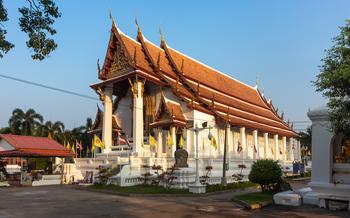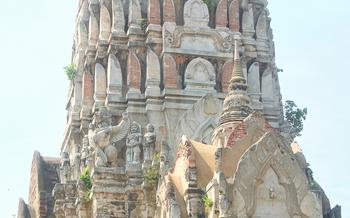
Wat Klang
- Wat Klang: A Historical and Spiritual Gem in Buriram
- Exploring the Ubosot: A Sacred Chamber
- Marveling at the Buddha Images
- Witnessing the Monastic Life
- Attending Temple Festivals and Events
- Exploring the Temple Grounds
- Interacting with the Locals
- Discovering Nearby Attractions
- Tips for Visiting Wat Klang
- Capturing Memorable Moments
- Insider Tip: Unveiling Hidden Treasures
Wat Klang: A Historical and Spiritual Gem in Buriram
History and significance of Wat Klang
Wat Klang, also known as Wat Klang Muang, is a revered Buddhist temple located in the heart of Buriram, Thailand. It holds immense historical and religious significance, having been established in the 16th century during the Ayutthaya Kingdom. The temple's name, which translates to "Middle Temple," reflects its central location within the city. Wat Klang has served as a spiritual and cultural hub for the local community throughout its long history, attracting devotees and visitors from far and wide.
Unique architectural features of the temple
Wat Klang showcases a blend of architectural styles, including traditional Thai and Khmer influences. Its most striking feature is the towering prang, a central spire reaching towards the sky and symbolizing Mount Meru, the sacred mountain in Buddhist cosmology. The temple's ubosot, or ordination hall, is adorned with intricate carvings and sculptures, depicting scenes from Buddhist mythology and showcasing the exceptional craftsmanship of the artisans who built the temple.
Religious importance and local beliefs
Wat Klang is deeply revered by the local community for its religious significance. It is believed to be the home of a revered Buddha image known as Phra Chao Tan Jai, which is said to possess miraculous powers and grant wishes to those who pray with sincerity. Locals flock to the temple to pay homage to the Buddha image and seek blessings for their families and loved ones.
Exploring the Ubosot: A Sacred Chamber
At the heart of Wat Klang stands the Ubosot, a sacred chamber where monks gather for religious ceremonies and meditation. This awe-inspiring structure is adorned with intricate mural paintings that narrate the life of Buddha and depict scenes from Buddhist cosmology. The walls are adorned with vibrant colors and delicate brushstrokes, creating a mesmerizing tapestry of stories and symbols.
Each mural tells a unique tale, showcasing the journey of Buddha from his birth to his enlightenment and ultimate Nirvana. The artists have skillfully captured the essence of these stories, bringing to life the characters and events that shaped the life of the Buddha. The murals serve as a visual guide, offering insights into the teachings and principles of Buddhism.
In addition to the murals, the Ubosot houses several Buddha images, each with its own distinct features and significance. These images are revered by the local community and are believed to possess sacred powers. Visitors can pay their respects and make offerings to the Buddha, seeking blessings and guidance on their spiritual path.
Marveling at the Buddha Images
Within the sacred confines of Wat Klang, visitors are captivated by the diverse collection of Buddha images, each radiating a unique aura of serenity and divinity. These statues, crafted with intricate detail and imbued with profound symbolism, narrate the rich history of Buddhism and its profound influence on Thai culture.
One of the most revered Buddha images is the Phra Ubosot, enshrined within the temple's main sanctuary. This colossal statue exudes an aura of majesty, its serene countenance inviting contemplation and introspection. The Phra Ubosot represents the embodiment of enlightenment, reminding visitors of the Buddha's teachings on the path to liberation.
Another notable Buddha image is the Phra Nak, renowned for its exquisite craftsmanship and historical significance. Believed to date back to the Ayutthaya period, this statue showcases the artistic prowess of that era. Its intricate headdress and ornate jewelry reflect the grandeur of the Ayutthaya Kingdom, a testament to the enduring legacy of Thai artistry.
Visitors can also marvel at the Phra Sangkachai, a revered Buddha image associated with wealth and prosperity. Devotees often pay homage to this statue, seeking blessings for financial success and material well-being. The Phra Sangkachai serves as a reminder of the interconnectedness of spirituality and worldly pursuits in Thai Buddhist culture.
Witnessing the Monastic Life
Wat Klang is not just a place of worship but also a vibrant center of monastic life. The temple is home to a community of monks and novices who dedicate their lives to the study and practice of Buddhism. Visitors to Wat Klang have the unique opportunity to observe the daily routines of these monks, gaining insights into their spiritual practices and way of life.
The monks at Wat Klang rise early each morning for their daily prayers and meditation sessions. They spend the rest of the day engaged in various activities, such as studying Buddhist scriptures, performing rituals and ceremonies, and providing guidance to laypeople. Visitors can witness these activities firsthand, gaining a deeper understanding of the Buddhist monastic tradition.
Interacting with the monks is a rewarding experience for visitors. The monks are typically friendly and welcoming, and they are happy to share their knowledge and insights about Buddhism. Visitors can ask questions, engage in conversations, and learn about the principles and practices that guide the lives of these dedicated individuals.
Attending Temple Festivals and Events
Wat Klang is renowned for its vibrant temple festivals and events that draw devotees and visitors from near and far. These celebrations offer a unique opportunity to immerse in the rich cultural traditions of Buriram. The temple's annual Ubosot festival, held during the month of Visakha Puja, is a grand spectacle that commemorates the birth, enlightenment, and passing of Lord Buddha. The temple grounds are adorned with colorful decorations, and elaborate processions featuring sacred Buddha images take place, accompanied by traditional music and dance performances.
Another significant event is the Kathin ceremony, which marks the end of the Buddhist Lent. During this time, devotees offer new robes to the monks as a symbol of merit-making. The temple buzzes with activity as locals participate in processions and engage in merit-making activities. These festivals provide a glimpse into the deep-rooted Buddhist beliefs and practices that are an integral part of Thai culture. Visitors can join in the festivities, make offerings, and experience the joyous atmosphere that fills the temple during these special occasions.
Exploring the Temple Grounds
As you wander through the temple complex, immerse yourself in the tranquil beauty of the lush gardens, serene ponds, and sacred trees that adorn the grounds. These natural elements hold deep symbolism and significance within the Buddhist tradition. The gardens represent the path to enlightenment, with each flower and plant symbolizing a different aspect of the Buddha's teachings. The serene ponds are a reminder of the importance of stillness and reflection, while the sacred trees offer a sense of peace and tranquility. Find a tranquil spot beneath the shade of a tree, close your eyes, and allow the serenity of the surroundings to wash over you. Take this opportunity to meditate and reflect on your own journey towards inner peace and enlightenment.
Interacting with the Locals
The community surrounding Wat Klang is known for its warmth and hospitality, making it a great opportunity to interact with the locals and gain insights into their way of life. Engage in friendly conversations with the vendors selling offerings and souvenirs, or seek blessings from the monks who reside within the temple grounds. Learn about local customs and traditions, such as the significance of merit-making and the importance of respecting elders. Support local businesses by purchasing handmade crafts, sampling delicious street food, or dining at nearby restaurants. The locals are always eager to share their stories and experiences, offering a unique glimpse into the vibrant culture of Buriram.
Discovering Nearby Attractions
Beyond the captivating allure of Wat Klang, Buriram unveils a tapestry of hidden gems waiting to be explored. Embark on a journey through time as you visit ancient temples that have stood the test of centuries, each narrating a unique chapter in the region's rich history. Delve into the depths of the past at Prasat Hin Phanom Rung, a magnificent Khmer sanctuary adorned with intricate carvings that transport you back to a bygone era.
Immerse yourself in the vibrant tapestry of local life at Buriram's bustling markets. Haggle for bargains, savor the tantalizing aromas of street food, and uncover the hidden treasures of local craftsmanship. Indulge in the culinary delights of the region, sampling the fiery flavors of som tam and the sweet perfection of mango sticky rice.
Venture into the surrounding countryside, where verdant rice paddies stretch as far as the eye can see, and lush forests beckon with promises of adventure. Discover hidden waterfalls, explore tranquil lakes, and encounter the friendly locals who call this region their home. Buriram offers a harmonious blend of cultural immersion, historical exploration, and natural wonders, ensuring an unforgettable journey for every traveler.
Tips for Visiting Wat Klang
When visiting Wat Klang, it is essential to adhere to certain guidelines to ensure a respectful and fulfilling experience. First and foremost, visitors should dress appropriately, covering their shoulders and knees. Shoes should be removed before entering the temple's sacred spaces. Maintaining silence and a peaceful demeanor is expected to preserve the tranquility of the temple grounds. Photography is permitted, but visitors should be mindful of not disturbing others or capturing images of monks without their consent. Making donations to the temple is a common practice to support its upkeep and preservation. These contributions help maintain the temple's beauty and ensure its continued existence for future generations.
Capturing Memorable Moments
Wat Klang's beauty and spiritual essence are best captured through photography. With its intricate architecture, stunning murals, and serene landscapes, the temple offers endless opportunities for photography enthusiasts. Remember to be respectful and avoid using flash when taking pictures of the Buddha images or during religious ceremonies. Instead, embrace the natural light and shadows that enhance the temple's charm. Explore different angles and perspectives to capture unique shots that showcase the temple's grandeur. Your photographs will serve as cherished mementos of your visit, allowing you to relive the tranquility and spirituality of Wat Klang long after your departure.
Insider Tip: Unveiling Hidden Treasures
Beyond the main attractions of Wat Klang, there are hidden gems waiting to be discovered by curious travelers. Engage in friendly conversations with the locals and inquire about lesser-known areas or unique features within the temple complex. They may point you towards secluded meditation spots, ancient artifacts, or hidden chambers that hold special significance. Explore the surrounding villages to witness traditional Thai craftsmanship, where skilled artisans create intricate textiles, pottery, and other handicrafts. These interactions not only provide a deeper understanding of the local culture but also support the preservation of traditional arts and livelihoods.
